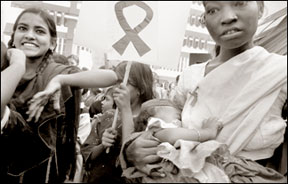How vulnerable are you?
World AIDS Day falls on Dec. 1:
by Rosanne Koelmeyer Anderson
Getting closer to self-destruction? A pressing issue which needs to
be promptly addressed According to UNAIDS estimates, there are now 39.5
million people living with HIV, including 2.3 million children.
 During 2006 some 4.3 million people became newly infected with the
virus. Around half of all people who become infected with HIV do so
before they are 25 and are killed by AIDS before they are 35. These
alarming figures are food for thought. Are we looking at a future
generation of 'sick,' psychologically, mentally and physically disturbed
individuals? During 2006 some 4.3 million people became newly infected with the
virus. Around half of all people who become infected with HIV do so
before they are 25 and are killed by AIDS before they are 35. These
alarming figures are food for thought. Are we looking at a future
generation of 'sick,' psychologically, mentally and physically disturbed
individuals?
Currently only 9 per cent of pregnant women living with HIV in the
developing world are provided with drugs to prevent the virus being
transmitted to their babies. As a result, half a million children become
infected with HIV every year and 'The Stop AIDS in Children campaign' is
calling on governments and international agencies to urgently improve
the situation.
The 2007 theme, 'leadership', highlights the need for innovation,
vision and perseverance in the face of the AIDS challenge. The campaign
calls on all sectors of society such as families, communities and civil
society organisations - rather than just governments - to take the
initiative and provide leadership on AIDS.
How far is all this effective? Is anything concrete really happening
or is the silent killer getting the better of thousands of lives
annually or are we really trying to make a significant change in the
lives of others to face the challenges of AIDS? Trafficking is a complex
issue and the root cause of the spread of HIV/AIDS.
It is an economic problem in that a vast majority of women seeking to
escape poverty are lured into trafficking by the false promise of
economic gain, it is a health problem as trafficked women and children
are most at risk from HIV infection, it is a gender problem as unequal
power reinforces women's secondary status in society.
It is also a legal problem as victims are stripped of their human
rights and lack access to redress for crimes committed against them.
Though women and girls in South Asia are trafficked for other
purposes besides sexual exploitation, this remains the single largest
category of exploitative trafficking crime throughout the world where
majority of victims are young girls and women from poor, illiterate
families the UNDP 2007 report states.
Although the official figures from the Sexually Transmitted Diseases
Clinic in Sri Lanka are much lower, the actual number of people living
with HIV is estimated by UNAIDS to be 3,500. HIV-prevalence country in
the South Asian region, with an estimated adult prevalence rate of less
than 0.1 per cent.
The Western Province accounts for 60 per cent of HIV infections with
the Central and Northwestern Provinces each accounting for 8 per cent
and the Northeastern Province for 7 per cent.
Nearly 90 per cent of the reported HIV infections are seen in the age
group of 15-49 it is said. What does this connote? Has the carefree
Colombo lifestyle contributed to these figures? The question then
arises, do parents have to put restrictions to children about the
company they keep, partying, clubbing, having intimate relationships at
a very tender age and being outdoors most of the time unsupervised? In
circumstances such as these it is nothing but compulsive to do so in
order to save the dying race and enjoy a better tomorrow.
[email protected]
|
